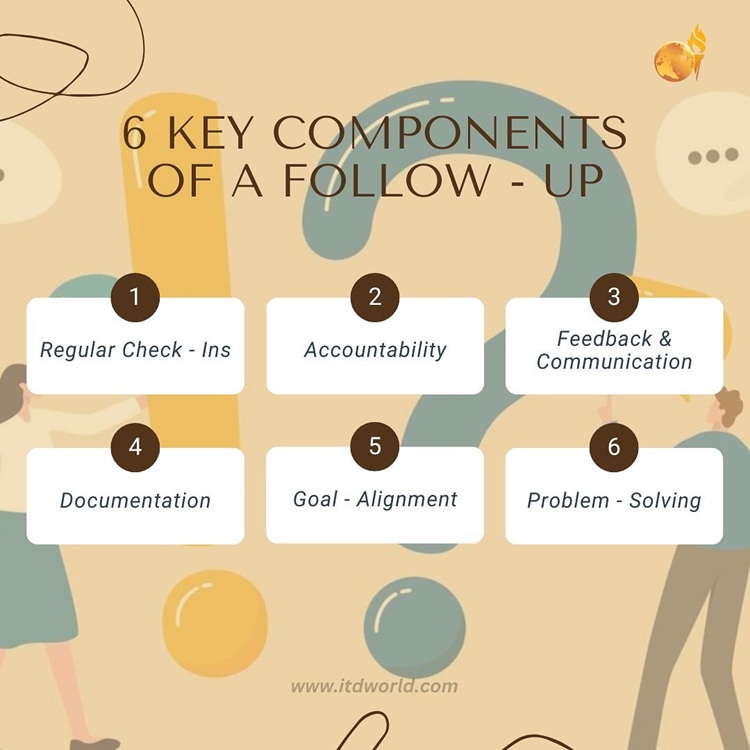Change is inevitable in the journey toward professional mastery; and yet, it is a winding path riddled with obstacles and temptations to revert to old habits and routines. That’s where follow up comes in; it is the linchpin that holds the grand tapestry of change together, ensuring that progress is continually made. Let us explore the significance of follow-up, including why it is crucial for long term behavior change and leadership effectiveness.
|
Author: Jonathan M. Pham |
Highlights
- Follow-up is a structured process of monitoring progress and ensuring accountability to achieve goals through regular communication, feedback, and problem-solving.
- A crucial component of behavior change, consistent follow up helps combat waning motivation, provides positive reinforcement, and builds self-efficacy. The process provides external oversight and collaborative support, ensuring commitment and reducing isolation during personal change.
- Effective leadership relies on follow-up to provide feedback, monitor progress, coach team members, and facilitate self-reflection for continuous improvement.
- Effective follow-up involves daily self-reflection through targeted questions and consistent external feedback solicitation.
- Success of follow-up strategies can be measured by assessing behavior change and leadership outcomes and processes using both quantitative and qualitative methods.
What is Follow Up?
Follow-up refers to a systematic and deliberate process of tracking, monitoring, and assessing progress or outcomes related to a specific goal, task, or initiative. It involves a series of actions and interactions aimed at ensuring that commitments, plans, or objectives are being actively pursued and ultimately achieved.
Typically, follow up is made up of the following key components:
- Regular check-ins: These include scheduled meetings, reviews, or touchpoints at specific intervals; they serve as opportunities to assess progress, address challenges, and make necessary adjustments.
- Accountability: Follow up establishes a sense of responsibility among those involved. When everyone is aware of their own accountability, they are more likely to stay committed to the goals set.
- Feedback & communication: Effective follow-up requires open and transparent communication. It involves not only asking for updates, but also actively listening to others and being receptive to concerns/ suggestions from related parties.
- Documentation: The process typically requires keeping records of progress and outcomes, which serve as the baseline for analysis, evaluation, and future planning.
- Goal alignment: Follow-up ensures that actions and outcomes align with the overarching objectives. It helps in maintaining focus and preventing deviations from the intended path.
- Problem solving: When obstacles or challenges arise, follow-up provides a platform to brainstorm solutions, allocate resources, and make necessary course corrections.

Why Follow Up Matters: The Psychology of Behavior Change
We are all aware of the need for behavior change – the process of modifying one’s habits, actions, or attitudes to achieve a desired goal – in our self development journey. While the aspiration is universal, the path to transformation is often littered with obstacles and pitfalls.
Behavior change is not merely about wanting to be better; it’s about rewiring the intricate circuitry of our minds. It necessitates breaking free from the comfort zones of routine – and confronting the discomfort of the unfamiliar. As such, it is an extremely challenging process – owing largely to the complex web of psychological factors that govern our behaviors.
- Lack of motivation: One of the primary hurdles is the ebb and flow of motivation. We may start with immense enthusiasm, only to see it wane as the days go by. The initial spark may fade, but follow-up helps reignite it. Regular check-ins serve as a reminder of why the change is essential, helping to sustain motivation over time.
- Lack of positive reinforcement: Our brains are wired to seek rewards and positive outcomes. When a change doesn’t yield immediate rewards, we tend to revert to old bad habits. Follow-up helps create a system of positive reinforcement, as each small step toward the goal is acknowledged and celebrated.
- Lack of self-efficacy: Far too often, we find ourselves wondering if we have what it takes to change. Follow-up provides evidence of progress, reinforcing our belief in our capacity to change and succeed.
Follow Up Ensures Accountability
Follow-up is how we remind people that we’re making an effort to change, and that they are helping us. It is how our efforts eventually get imprinted on our colleagues’ minds.
Marshall Goldsmith – world #1 executive coach
Part of follow up’s effectiveness stems from external accountability, which is a psychological force that cannot be underestimated. When we know that someone else is watching our progress, we are much more likely to stay committed to our goals. Not to mention, we are also provided with a sense of belonging and trust, which helps reduce the sense of isolation that often accompanies personal transformation.
Follow-up isn’t just about self-monitoring; it’s a call for collaboration. When others are part of the follow-up process, they become allies in your journey. Their encouragement, insights, and assistance are invaluable assets that serve as a guiding light for us to navigate the twists and turns of development successfully.
Read more: Accountability Partner – How Does It Work?

Follow Up is Necessary for Changing Behavior & Visualizing Goals
Follow-up is more than just a procedural step; it is the lifeblood of growth – the crucial ingredient that propels us toward transformation:
- Demonstrate care and commitment
When following up on our goals, we send a clear message to ourselves and those involved that we genuinely care about our progress – and are authentically committed to the process. It’s an act of respect and gratitude towards our own aspirations and the people who support us along the way.
- Measure progress & gather feedback
Follow-up serves as a mirror to our journey; it reflects what we have accomplished so far, while at the same time highlighting the distance yet to be covered. It’s a tool for measurement that allows us to track our progress objectively.
Additionally, it opens the door to honest feedback from others, enabling us to gain valuable insights, reflect on previous mistakes, and fine-tune our actions.
- Celebrate success & learn from mistakes
Success often consists of a series of small victories. Follow-up provides the opportunity to celebrate these achievements, no matter how “trivial” they may seem. Awareness of one’s progress fuels motivation and reinforces positive behavior.
On the other hand, in the case of setbacks, follow-up helps us understand why they happened and how we can adjust our strategies for better outcomes in the future.
- Create a positive cycle of reinforcement
Consistent follow-up doesn’t just track progress; it actively shapes our mindset. It boosts self-confidence by showcasing how far we’ve come – as well as enhances self-discipline by holding us accountable for our commitments, and fosters self-awareness by shedding light on our strengths and areas for improvement. This positive reinforcement creates a self-perpetuating cycle that strengthens our resolve and keeps us moving forward.
- Inspire others
When we actively pursue our goals and consistently follow up on our progress, we become inspiring figures to those around us. Our dedication serves as a model for others to embark on their own journeys of growth and change.
In one of the largest studies ever done on the effects of executive coaching – over 70,000 respondents – we learned that the biggest mistake coaches make is in not following up. It didn’t matter who the coach was or what method they used. Failing to follow up made any approach to coaching ineffective.
Marshall Goldsmith
Leadership and Follow-Up
Follow up lies at the heart of effective leadership; in fact, it is one of the most powerful tools in a leader’s arsenal to foster success.
-
Feedback & recognition
Follow up provides the chance for leaders to offer constructive and timely feedback to their team members – which serves as a compass that guides them toward improvement. On the other hand, it is also an opportunity to acknowledge and appreciate the efforts/ achievements of others – which is crucial to boosting morale, reinforcing positive behavior, and fueling motivation.
Read more: Giving Effective Feedback – A Practical Guide for Success
-
Monitoring & evaluation
Ongoing follow up and assessment helps identify any emerging issues, challenges, or opportunities. As such, leaders are better equipped to come up with informed decisions, adjust strategies, allocate resources optimally, and ensure that the team stays on course towards success.
-
Coaching & mentoring
Part of a leader’s job is to guide and support team members in their journey – which is achievable with constant follow ups. Through coaching and mentoring, leaders enable others to acquire new skills, knowledge, and perspectives to overcome obstacles and challenges – while at the same time encouraging open dialogue and idea exchange, thereby laying the foundation for innovation and strengthened team bonds.
Read more: Building High-performing Teams – How to Power Up Your People
-
Reflecting & improving
Leadership is not just about leading others; it’s also about handling oneself. Follow up is essential for ones to reflect on their own leadership style, behavior, and impact.
Seeking feedback from team members and peers allows leaders to identify and address interpersonal problems that may hinder relationships or performance, thereby enhancing self-awareness and regulation. It’s a commitment to continuous self-improvement.
Read more: Leadership Feedback – How to Change for the Better
How to Follow Up
Follow-up is a dynamic process that can take various forms; here, we will go over two powerful methods that can be harnessed for holistic growth.
The Daily Question Process
The “Daily Question Process” is a straightforward, yet remarkably effective method for monitoring progress and maintaining accountability. Popularized by leadership coach Marshall Goldsmith, it involves asking yourself a set of questions on a daily basis – so as to better reflect on your desired behaviors and goals.
Here’s how it works:
- Select relevant questions: Choose questions that align with your personal or professional objectives – those that prompt reflection on the specific actions or behaviors you aim to cultivate. For example, “Did I exercise today?”, “Did I meditate today?”, or “Did I make someone smile today?”
- Rate yourself: After each day, rate yourself on a scale of 1 to 10 for each question. Be honest and objective in your assessments. Did you meet your goals? How well did you perform?
- Track progress: Over time, maintain a record of your daily scores. This tracking process allows you to observe trends, identify areas where you consistently excel, and pinpoint those that need improvement.
The daily question process serves as a powerful motivator. Knowing that you will assess your progress each day cultivates a sense of accountability – while at the same time reinforcing commitment to your goals and providing a clear path for improvement.
Asking for feedback
While self-assessment is valuable, an external perspective is equally insightful. Asking for feedback from others is a cornerstone of continuous improvement, both personally and professionally.
- Set a feedback schedule: Establish a routine for soliciting feedback from colleagues, mentors, friends, or family members. This can be on a monthly or quarterly basis, depending on your goals and preferences.
- Choose the right people: Select those who are able to provide constructive and honest feedback. These should be individuals who are familiar with your goals and capable of providing insights.
- Ask specific questions: When seeking feedback, ask specific questions that relate to your objectives. For instance, if you’re working on leadership skills, inquire about your communication style, teamwork, or problem-solving approach.
- Express appreciation: After receiving others’ input, express gratitude to those who took the time to participate in discussions with you. Appreciation fosters goodwill and encourages ongoing support.
- Take action: Act on the input received. Use it as a roadmap for improvement and adjust your strategies accordingly. Continuously seek feedback to gauge your progress and make necessary refinements.
Regularly requesting feedback from others not only helps you gain insights into your performance but also strengthens relationships and builds trust. It’s a powerful tool for achieving lasting positive change in both your personal and professional life.
How to Measure the Success of Follow-up Strategies
To assess the impact of follow-up in behavior change and leadership, consider using key metrics and indicators that reflect the effectiveness of your efforts, including:
- Behavior change outcomes
These represent the tangible results or impacts of your behavior change interventions. They can encompass improved health, enhanced performance, increased satisfaction, or overall well-being.
Measure these outcomes using both objective and subjective methods. Objective measures include data from surveys, tests, observations, or other quantitative assessments. Subjective measures can involve self-reports and qualitative feedback.
- Behavior change processes
Behavior change processes are the mechanisms and factors that facilitate or hinder your behavior change interventions. They include motivation, knowledge acquisition, social support, or self-efficacy.
Assess them using a mix of qualitative and quantitative methods. Techniques such as interviews, focus groups, questionnaires, and scales may provide very valuable insights into the effectiveness of your strategies.
- Leadership outcomes
Leadership outcomes encompass the results or impacts of your leadership interventions. These may include increased productivity, higher profitability, enhanced innovation, improved engagement, or other relevant measures.
Use financial and non-financial methods to gauge these outcomes. Financial measures could involve tracking sales, profits, market share, or cost savings. Non-financial measures may include metrics like customer satisfaction, employee retention, and feedback from stakeholders.
Read more: Stakeholder Management – A Leader’s Engagement Playbook
- Leadership processes
Leadership processes are the mechanisms and factors that either facilitate or hinder your leadership interventions. They can encompass elements like vision setting, strategic planning, effective communication, collaboration, and feedback mechanisms.
Nowadays, the emergence of new tools has tremendously aided in facilitating effective follow-up – by automating data collection and analysis, streamlining the process, providing real-time feedback, and enhancing communication and collaboration among those involved. For instance, ITD World’s Let’s Coach app is a prime example of how technology can aid in tracking progress, maintaining accountability, and driving successful follow-up initiatives.
Read more: 360 Degree Feedback – From Theory to Action

Final Thoughts
Follow up, in its essence, is more than just a mere check-in or a routine task. It’s the glue that binds intentions to actions – and aspirations to achievements. Whether in personal development, project management, or leadership, it is the compass that keeps us on course, and ensures that our efforts lead to meaningful and lasting change.
Other resources you might be interested in:
- Performance Coaching: Unlock People’s Greatness
- Employee Development Plan: Fueling Future Success
- Aligning Individual Goals With Organizational Goals: A How-to Guide

